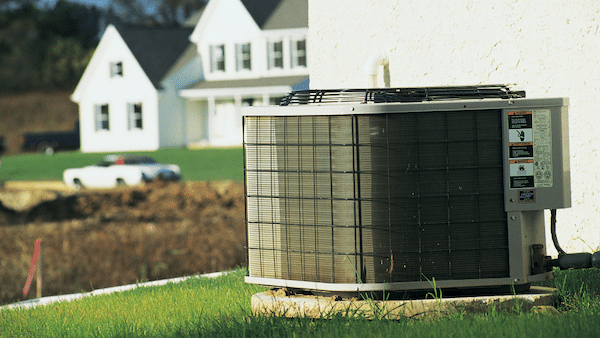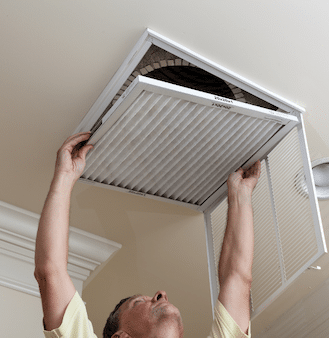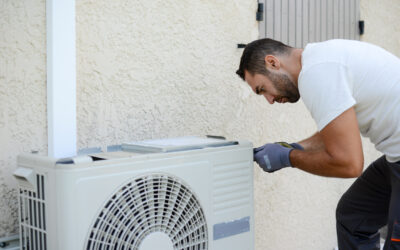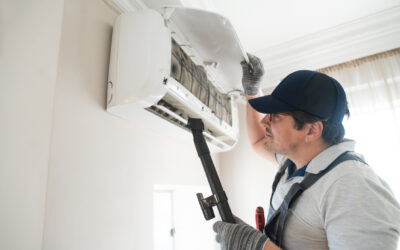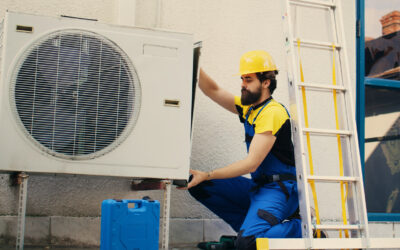As cooler temperatures slowly leave Hampton Roads and make way for warmer weather, April is the perfect time of year to give your air conditioning unit a check-up. Be sure to add your AC unit to your list of indoor and outdoor spring-cleaning projects. There are two huge benefits to conducting a once-over on your air conditioner before warm weather hits. One, a clean well-maintained machine will run more efficiently and last longer – saving you money in monthly utility bills and potential future repair costs. Two, a regular AC check-up before the prime of the summer season can identify any major problems with your system. These problems, if not addressed, may lead to your home being stuck without a cooling unit come the real hot period. Following are 5 steps to ensuring your air conditioning unit is ready for the summer season.
Clean The Condenser
The air conditioner condenser is a large square unit located outside of your home. It will typically look like a large metal box with a fan inside. Throughout the year leaves, pine needles, and various debris will collect inside of the condenser. By clearing out this debris, you will reduce the chances of mold and corrosion in your unit. Before you do anything, ensure that the power is in the off position. If you are uncertain, shut off power to the air conditioning condenser from your main electrical power box. Gently unscrew the top grille and vacuum or hand-remove debris. Once the debris is sufficiently removed, tighten any mounting bolts that may be loose, re-attach the top grille, and re-establish power.
Check Coolant Lines
Coolant lines are pipes that typically run from the evaporator on the air handler (inside of your home) to the condenser unit (outside of your home). These pipes, or sometimes refrigerant tubes, are encased in foam insulation to keep them as energy-efficient as possible. Check the coolant lines and inspect the foam covers for frayed areas or missing foam insulation. Replace the damaged areas with fresh foam insulation sleeves in order to reduce additional damage to the tubing and reduce loss of energy.
Clear And Clean The Drain Line
Drain lines are PVC piping that draws moisture and condensation away from the indoor air handler unit to the outside. These lines are notorious for causing significant water damage to homes if clogged and harboring mildew and moldy odors. To start cleaning your AC drain line, begin with the condensate or drain pan – typically kept under the interior air handler unit. If there is standing water in the drain pan, this could be an indicator that your drain line is clogged. Using a shop vacuum with wet/dry capabilities, remove water and moisture from the pan. Once the moisture is completely removed from the drain pan, you can clean it with soap.
To clear the line of a clog, use the suction of the shop vacuum at the exterior base of the pipe. The exterior base of the drainpipe is typically located near your outside condenser. A shop vacuum should be able to dislodge a stubborn clog.
Once you have vacuumed the base of the drain pipe and the clog is removed, you may choose to clean and flush the line. Start with the access point on the drain line. The drain line will have a t-shaped vent with a PVC cover. This should be the access point. After removing the cover, you can choose your preferred home cleaning formula. Here are a couple of home cleaning remedy options: distilled vinegar, hot water with a drop of dish liquid, peroxide, or one cup of bleach. Pour your desired cleaner and allow it to sit for a half-hour. Follow-up with a water flush in the pipe. Ideally, you will have a helper watching outside to ensure that the water is running freely from the out spout.
Checking and cleaning your condensate pan and drain line will not only keep your AC unit running smoothly, but it will also address possible drain issues before they turn into major water damage to your home.
Replace Filters
Depending on the type of filter that your home’s cooling system uses, it should be replaced as frequently as twice a year up to every 30 days. The proper replacing of the furnace or air-handler filter helps to keep your system running efficiently. If the filter is loaded with dust and dirt, it will restrict the flow of air and cause your home’s cooling system to work harder to cool to your liking. Anytime a system is strained and working harder than it should, equates to a higher utility bill for you and an increased likelihood of repair work for your system down the road.
Reset Your Thermostat
Especially essential if you have a programmable or smart thermostat, be sure to re-calibrate your home’s thermostat settings for the spring and summer months. Increasing your home’s thermostat setting by 7-10 degrees when the home is unoccupied and during sleeping hours of the night can add up to savings on your monthly utility bill. In fact, Energy.gov claims that you can save as much as 10% a year on cooling costs by raising your thermostat settings between 7-10 degrees for at least eight hours a day from your normal setting in the summer months. The spring months are a great time to upgrade your thermostat as well. Whether you are considering upgrading your thermostat from a manual to a programmable or smart thermostat, make sure you manage the settings for optimum energy efficiency.
Consider A New System
If you follow these maintenance steps and find that your system is not up to par, it may be time for a new cooling system for your home. If your home’s air conditioning system is ten years or older, you may be surprised at the increased cost of repair, in part due to the short supply of a necessary coolant known as R-22. Additionally, newer air conditioning systems have improved upon their energy efficiency. While an older cooling unit that is struggling to function properly may be driving your utility bills sky-high in the scorching summers we have in Hampton Roads, a newer energy-efficient model can save 20 – 40% on cooling energy costs versus a unit that is 10 years old, according to Energy.gov.
Call The Experts
Whether you are in need of a new air conditioning system or would like help managing your existing system, Smith & Keene is here to help. Smith & Keene’s expert technicians will come to your home and provide you with recommendations for the right system for your home’s heating and cooling needs and improve your energy costs.
Looking for peace and mind to maintain your home’s air conditioning unit? Consider Smith & Keene’s Signature Service Plan. Smith and Keene’s technicians will develop a customized maintenance plan to regularly inspect your home’s heating and cooling units. In addition to the service, the Signature Service Plan includes several membership perks such as extended service hours and repair discounts.
Contact Us
When your system isn't working, IT'S TIME to contact the HVAC experts in Hampton Roads, Smith & Keene



